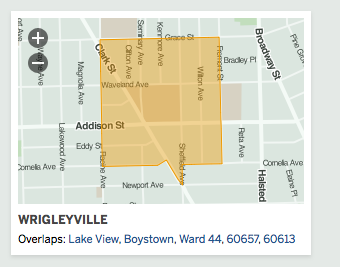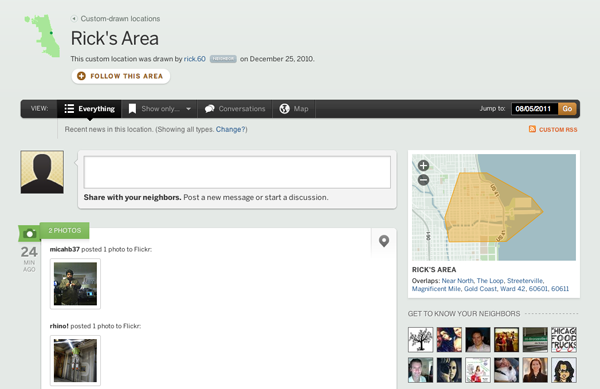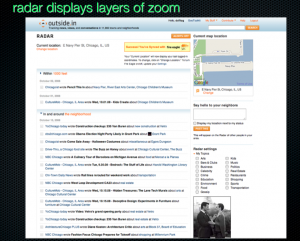layers of zoom: where are you now?
The amount of information available for any given area controls the levels of zoom. The information on outside.in and EveryBlock are aggregated from publishers (news sites) or bloggers (user-submitted blogs). For areas like New York, San Francisco, and Chicago, there are a wealth of news sources and blogs from which to pull information. However, in areas like Champaign-Urbana, there are only three sources of information submitting content to the site. Obviously, the amount of information produced by these sources is restricted, which limits the possibilities of zoom and layers of localities.
EveryBlock creates layers of zoom through its use of maps. Instead of relying on third-party applications such as GoogleMaps, EveryBlock designs its own maps in order to have more design control, as well as to increase the layers of zoom. Using the map, one literally zooms in and out until the location in which they are interested comes into focus. Clicking on a link takes you to the specific stories related to the level of zoom.

Layers of Zoom in action on EveryBlock
Recently, EveryBlock has provided a way for users to create layers of zoom for themselves through the “draw your own neighborhood” feature, which allows users to track news in whatever area they choose. Other users can follow these custom areas, post comments, recommend real estate, and connect to others in the neighborhood. Below is an example from Rick's Area (2012), comprised of Chicago neighborhoods and represented on the customized map.

Users are able to determine their level of involvement in terms of zoom, moving through the site in a variety of ways, pausing on particular stories, real-time data, or custom neighborhoods to create place based on emotional proximity as well as geographic.
To further address issues of revelance, outside.in features a search bar where users input a category and location and returns results within 1,000 feet of the given location. The location may be as general as a metropolitan area (Chicago, IL) or as focused as a particular address (233 S. Wacker Drive). Previously, the feature, known as “Radar,” attempted to add levels of zoomand cover areas where social proximity may override geographic proximity. Radar allowed users to zoom any location down to the very intersection or neighborhood block at which he/she was standing while simultaneously reading news and gathering information from locations around the country which also interested the user. Like the microblog Twitter that asks users to answer, in 140 words or less, the question “What are you doing right now?,” Radar asked “Where are you right now?,” allowing users to further connect the online representations of their identities to location. The feature displayed the various layers of zoom for each user in real time. If you were at Navy Pier in Chicago, Radar showed your current location as 600 E. Grand Avenue. Under your current location, a kind of “news feed” of users who talked about, or posted pictures of, your location appeared. The next level of zoom included news feeds in and around Streeterville (the neighborhood which houses Navy Pier). The city of Chicago would be the next level of zoom and finally “Elsewhere on Radar.” Each layer of zoom included posts, comments, and pictures from other users. Currently, the search bar is intended to function as a layer of zoom, but in practice, it works more like a filter because the driving purpose of outside.in seems more focused on collecting and archiving than inviting user participation.

Radar features now part of the “search bar” on the current incarnation of outside.in
According to the outside.in blog, Radar has been integrated into the site experience, but as I searched the site, I saw very few of the Radar features in action. However, on the internal pages of the site, the individual region or neighborhood pages, users can search for specific topics and areas of interest in that specific location, which acts as an additional filter and layer of zoom for information aggregated on the site. Despite this additional layer of search, there is little interaction between the user and the content.
As the Radar feature disappeared from outside.in, other social media, including Facebook's "Places" feature, Gowalla, and FourSquare provided opportunities for users to share their locations, to answer “Where are you now?” Facebook Places is designed to let users tell their friends where they are while helping them track their own friends' whereabouts. Like most location-based applications, including Foursquare and Gowalla, the Facebook app for smart phones utilizes the GPS in users mobile phones to determine businesses, restaurants, and other locations in the area to which users can “check in.” It also allows users to tag their friends at the same location.

Facebook Places also syncs with other location-based social networks like Foursquare and Gowalla, which allows users to unlock badges and pins based on how many times they check in to particular places and how often they use the service. These “check-ins” appear in the Facebook News Feed and on the user's wall, the same way a status update would. In many ways, the check-in replaces the status update. Of course, answering the question, “Where are you now” means sharing your location publicly and also sharing where you are not. In February 2010, the website Please Rob Me launched to illustrate the dangers of oversharing your geo-physical location. The site simply aggregated publicly available information from Foursquare check-ins also posted to Twitter. The site garnered a great deal of attention, and some outrage, which was the entire point of the site: raising awareness about the need for locational privacy.
In addition to the data we provide to Facebook, Foursquare, Twitter, and apps that tell us what businesses and restaurants are nearby, locational data can currently be obtained from a number of sources including Google Satellite, electronic toll systems (EZ Passes, Fast Trak, etc), monthly transit cards, electronic swipe keys, and other GPS technologies. The question remains where does this data go? And who has control of it? How often are we surveilled and how often do we participate in our own surveillance? Founders of Please Rob Me and proponents of locational privacy measures supported by the Electronic Frontier Foundation would say, “too often.”
Outside.in and EveryBlock are just two examples of how new media technologies are helping users convey and deepen collective identities through hyperlocal content. The connections users make with one another in social media are typically based on proximity, either social or physical, because users are no longer residing in online spaces and then moving offline but rather moving between the two in a myriad of ways, most significantly creating web presences online for their geophysical location as a way to further construct and represent their collective identities. However, in doing so, users may be unaware of the potential risks of sharing their locations throughout the day, particularly when users of Facebook Places, for example, can be tagged by others whether they are aware of it or not. One has to “opt out” of the Facebook feature; the default is sharing your location publically.
While I have argued throughout this webtext that a hyperlocal focus is a way for users to build and deepen identities based on place, I am acutely aware of the questions and potential legal issues raised by doing so. Outside.in and EveryBlock are sites that serve as hyperlocal aggregates, places users can contribute and collect information about neighborhoods in their location, zooming in and out as necessary. These actions, I maintain, are about supporting and contributing to the online presence of a particular area, restaurant or neighborhood while the practices of “checking in” and gaining badges or pins through Foursquare and Gowalla are much more akin to the typical status message that shares what users are doing at any given point throughout the day; only here the focus is on “Where are you now” rather than “What are you doing?” I believe this shift is significant and that we have yet to see how the trend will pan out regarding success and consequence, but it certainly raises issues of privacy, data mining, and the deep-seated need to stay connected.


June